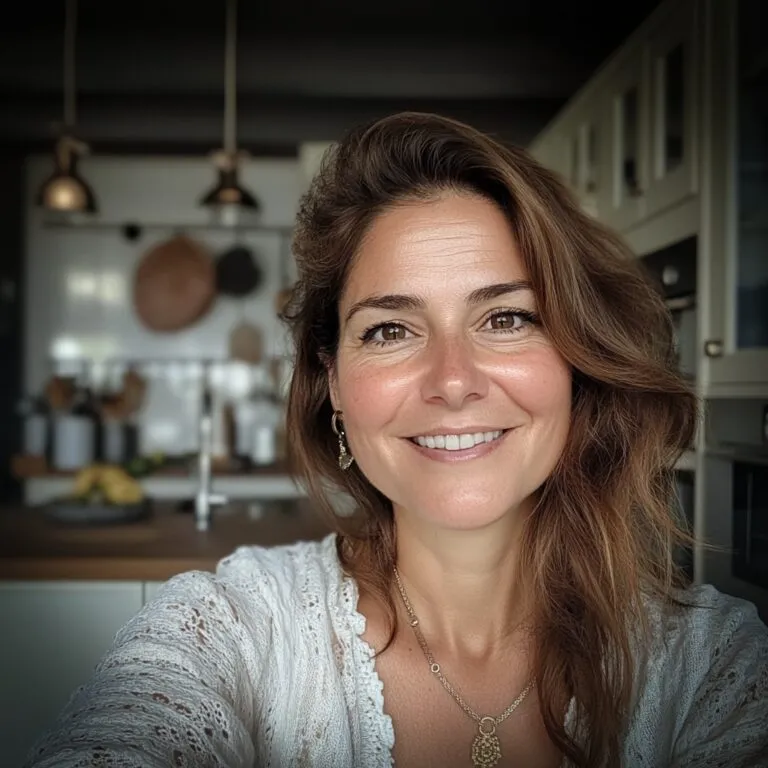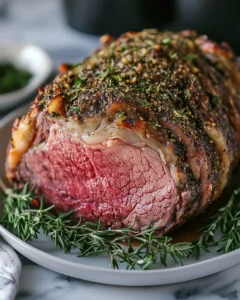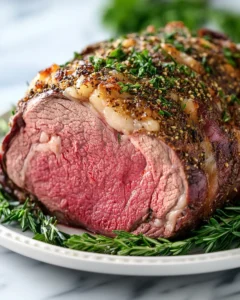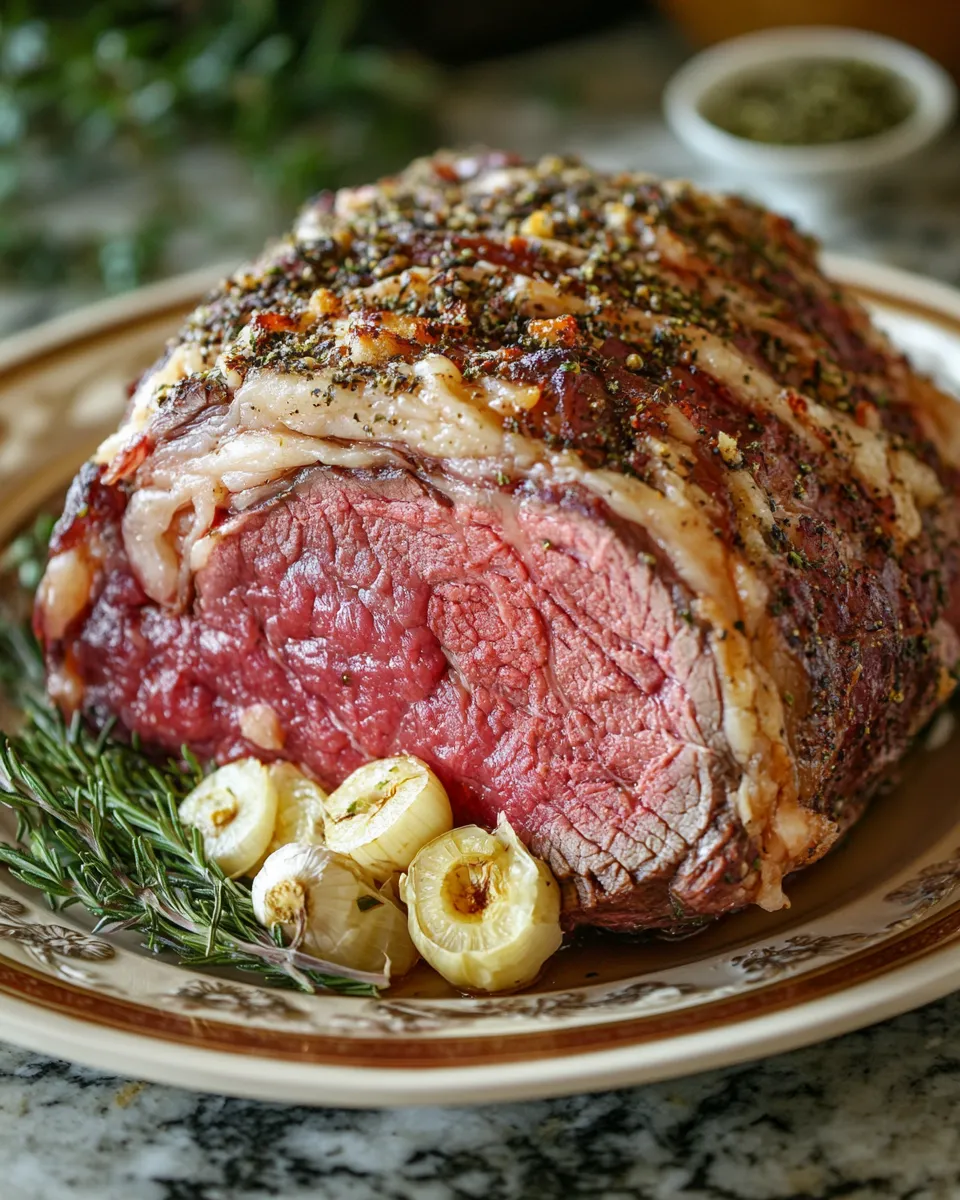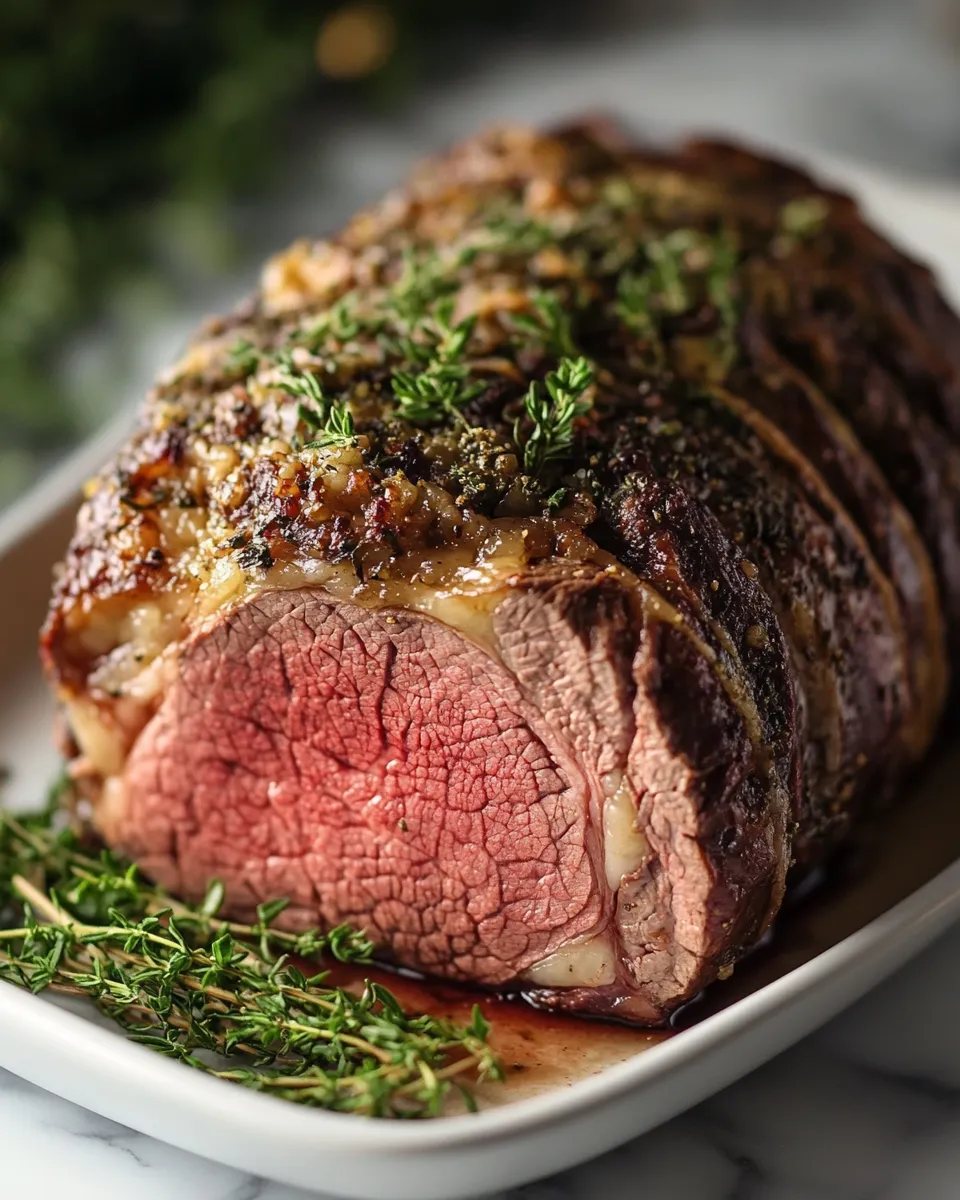There’s something undeniably special about a perfectly cooked prime rib roast. Imagine a festive holiday gathering or a cozy winter evening, with the aroma of herbs and roasted beef filling the entire home. The anticipation builds as the golden crust forms on the outside, locking in the juicy, tender meat within. This is more than just a meal—it’s an experience that brings family and friends together, a centerpiece that sparks conversation and admiration.
The inspiration for this recipe comes from traditional family gatherings where prime rib was the star of the table. Over the years, I perfected the combination of fresh herbs, garlic, and seasoning to create a crust that is bursting with flavor while keeping the meat incredibly tender. Whether you are hosting a holiday feast, celebrating a birthday, or simply treating yourself to a weekend indulgence, this herb-crusted prime rib roast is designed to impress every time.
Ingredients
-
1 (5–6 pound) bone-in prime rib roast
-
4 tablespoons olive oil
-
4 cloves garlic, minced
-
2 tablespoons fresh rosemary, finely chopped
-
2 tablespoons fresh thyme, finely chopped
-
2 tablespoons fresh parsley, finely chopped
-
1 tablespoon coarse sea salt
-
1 tablespoon freshly ground black pepper
-
1 teaspoon onion powder
-
1 teaspoon Dijon mustard (optional, for extra flavor)
-
1 cup beef stock (for resting and optional au jus)
Directions
-
Prepare the Prime Rib
Remove the prime rib from the refrigerator at least 2 hours before cooking to allow it to reach room temperature. This step ensures even cooking and prevents the roast from becoming tough. Pat the meat dry with paper towels to help the herb crust adhere properly. -
Preheat the Oven
Preheat your oven to 450°F (230°C). A high initial temperature helps to form a flavorful crust on the outside while sealing in the juices. -
Make the Herb Crust
In a small bowl, combine the olive oil, minced garlic, rosemary, thyme, parsley, sea salt, black pepper, and onion powder. Mix thoroughly to create a fragrant paste. For an extra layer of flavor, you can spread a thin layer of Dijon mustard on the roast before applying the herb mixture. -
Apply the Herb Mixture
Generously rub the herb paste all over the prime rib, ensuring that every side is covered. Don’t forget the ends and any exposed bone for maximum flavor. -
Roast the Prime Rib
Place the roast on a rack in a roasting pan, bone-side down. Insert a meat thermometer into the thickest part of the roast, avoiding the bone. Roast at 450°F (230°C) for 20–25 minutes to develop the crust. -
Reduce Temperature and Continue Roasting
After the initial high-heat roast, reduce the oven temperature to 325°F (165°C) and continue cooking until the internal temperature reaches 120°F (49°C) for rare, 130°F (54°C) for medium-rare, or 140°F (60°C) for medium. Depending on the size of the roast, this may take an additional 1.5–2 hours. -
Rest the Meat
Once the desired temperature is reached, remove the roast from the oven and transfer it to a cutting board. Tent it loosely with foil and let it rest for 20–30 minutes. Resting is crucial—it allows the juices to redistribute, ensuring every slice is juicy and tender. -
Prepare Optional Au Jus
While the roast rests, you can make a simple au jus by deglazing the roasting pan with beef stock. Scrape the browned bits from the pan with a wooden spoon, then simmer for 5–10 minutes. Strain if desired and serve alongside the roast. -
Carve and Serve
Using a sharp carving knife, slice the prime rib against the grain into thick, juicy slices. Serve immediately with your favorite sides such as roasted vegetables, mashed potatoes, or a fresh green salad.
Tips for the Perfect Herb Crusted Prime Rib
-
Use Fresh Herbs: Fresh rosemary, thyme, and parsley give the best flavor. Dried herbs can be used in a pinch, but they won’t deliver the same vibrant aroma.
-
Room Temperature Meat: Always allow your prime rib to come to room temperature before roasting. This prevents uneven cooking.
-
Invest in a Meat Thermometer: A reliable thermometer ensures your roast is cooked to perfection every time.
-
Let It Rest: Never skip the resting step. Cutting too soon results in a loss of juices.
-
Customize Your Crust: Experiment with adding garlic powder, smoked paprika, or even crushed black peppercorns for a unique twist.
Why This Recipe Stands Out
What sets this herb-crusted prime rib apart is the balance of flavors and textures. The initial high-heat roast creates a beautifully golden crust, while the slow, lower-temperature roasting guarantees a tender, melt-in-your-mouth center. The combination of fresh herbs and garlic infuses the meat with a savory aroma that fills your kitchen, making the cooking experience just as delightful as the meal itself.
Additionally, this recipe is designed to be accessible. Whether you’re a seasoned chef or a home cook trying prime rib for the first time, clear instructions and tips ensure success. By using simple ingredients and a straightforward technique, anyone can achieve a restaurant-quality roast in the comfort of their own home.
Serving Suggestions
Pair this herb-crusted prime rib with sides that complement its rich flavor. Classic options include:
-
Garlic Mashed Potatoes: Creamy and smooth, perfect for soaking up the roast’s juices.
-
Roasted Root Vegetables: Carrots, parsnips, and potatoes tossed in olive oil, salt, and herbs for a rustic accompaniment.
-
Steamed Asparagus or Green Beans: Adds a fresh, vibrant color and balances the richness of the meat.
-
Yorkshire Pudding or Dinner Rolls: Ideal for creating a complete, traditional roast dinner experience.
For sauces, consider horseradish cream, a simple au jus, or a savory mushroom gravy. These options enhance the roast without overpowering the delicate herb crust.
Storage and Leftovers
Leftover prime rib can be stored in an airtight container in the refrigerator for up to 3–4 days. For the best flavor, reheat gently in the oven at 300°F (150°C) until warmed through. Leftovers also make delicious sandwiches, salads, or steak tacos, allowing you to enjoy this luxurious roast for days.
Frequently Asked Questions
1. Can I use a boneless prime rib?
Yes, you can absolutely use a boneless prime rib for this recipe. Boneless cuts are easier to carve and may cook slightly faster than bone-in roasts because there is no bone to slow the heat transfer. However, because cooking times can vary depending on the size and shape of the roast, it’s essential to use a reliable meat thermometer to check for doneness. Aim for an internal temperature of 120°F (49°C) for rare, 130°F (54°C) for medium-rare, or 140°F (60°C) for medium. Keep in mind that the roast will continue to cook slightly while resting, so it’s a good idea to remove it from the oven a few degrees below your target temperature.
2. How do I make sure my roast is evenly cooked?
Even cooking starts with preparation. Allow your prime rib to come to room temperature for at least 2 hours before roasting. This step helps the heat penetrate the meat evenly, preventing the outside from overcooking while the center remains underdone. Using a meat thermometer is crucial, especially for larger roasts. Insert it into the thickest part of the meat, avoiding the bone, to get an accurate reading. After cooking, let the roast rest for 20–30 minutes. Resting allows the juices to redistribute throughout the meat, resulting in tender, flavorful slices rather than a dry exterior and undercooked center.
3. Can I prepare the roast ahead of time?
Yes! Preparing your roast ahead of time can enhance the flavor and reduce stress on the day of your meal. You can season the prime rib with herbs, garlic, and olive oil the night before and store it in the refrigerator. Overnight marination allows the seasonings to penetrate the meat more deeply, creating a richer, more aromatic crust. When you’re ready to cook, simply let the roast come to room temperature before placing it in the oven. This ensures even cooking and prevents the exterior from searing too quickly while the interior remains cold.
4. What if I don’t have fresh herbs?
If fresh herbs are not available, dried herbs are a suitable substitute. Use about half the amount of dried herbs compared to fresh, as dried herbs have a more concentrated flavor. For example, if the recipe calls for 2 tablespoons of fresh rosemary, use 1 tablespoon of dried rosemary. While fresh herbs provide a brighter, more vibrant flavor, dried herbs can still create a delicious and fragrant herb crust when combined with garlic, olive oil, and seasoning. You can also experiment by mixing different dried herbs to approximate the flavor profile of the fresh combination.
Conclusion
The best herb-crusted prime rib roast is more than just a meal—it’s a statement. It’s a centerpiece that transforms any occasion into a celebration, a dish that invites everyone to gather around the table and savor every bite. With its golden crust, juicy interior, and aromatic herbs, this prime rib recipe offers a restaurant-quality experience without leaving your kitchen.
Whether you’re preparing a holiday feast, a special family dinner, or simply treating yourself, this herb-crusted prime rib roast promises unforgettable flavor, impressive presentation, and a cooking experience you’ll be proud to share. Gather your ingredients, preheat the oven, and get ready to create a masterpiece that will be remembered long after the last slice is gone.
Print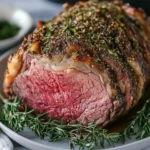
- Total Time: 2 hours 20 minutes – 2 hours 50 minutes
- Yield: 8–10 servings 1x
Description
A perfectly cooked prime rib roast is the ultimate centerpiece for any special occasion, whether it’s a festive holiday dinner or a cozy family gathering. This recipe combines fresh herbs, garlic, and a golden crust to create a tender, juicy, and flavorful roast that will impress everyone at the table. Inspired by traditional family recipes, this herb-crusted prime rib is designed to deliver restaurant-quality results in your own kitchen.
Ingredients
-
1 (5–6 pound) bone-in prime rib roast
-
4 tablespoons olive oil
-
4 cloves garlic, minced
-
2 tablespoons fresh rosemary, finely chopped
-
2 tablespoons fresh thyme, finely chopped
-
2 tablespoons fresh parsley, finely chopped
-
1 tablespoon coarse sea salt
-
1 tablespoon freshly ground black pepper
-
1 teaspoon onion powder
-
1 teaspoon Dijon mustard (optional)
-
1 cup beef stock (for resting or optional au jus)
Instructions
-
Remove the prime rib from the refrigerator at least 2 hours before cooking and pat dry with paper towels.
-
Preheat the oven to 450°F (230°C).
-
In a bowl, mix olive oil, garlic, rosemary, thyme, parsley, sea salt, black pepper, and onion powder to form a paste. Optional: spread Dijon mustard on the roast before applying the herb mixture.
-
Rub the herb paste generously over the entire roast, including the ends.
-
Place the roast on a rack in a roasting pan, bone-side down, and insert a meat thermometer into the thickest part.
-
Roast at 450°F (230°C) for 20–25 minutes to develop a crust.
-
Reduce the oven temperature to 325°F (165°C) and continue roasting until the internal temperature reaches 120°F (49°C) for rare, 130°F (54°C) for medium-rare, or 140°F (60°C) for medium.
-
Remove from the oven and tent loosely with foil; let rest for 20–30 minutes.
-
Optional: make au jus by deglazing the roasting pan with beef stock, simmer 5–10 minutes, then strain.
-
Slice against the grain and serve with sides of choice.
Notes
Allow the roast to come to room temperature before cooking for even results. Resting is essential to retain juices. Use a meat thermometer for accurate doneness. Adjust herbs to taste or experiment with dried herbs if fresh are unavailable.
- Prep Time: 20 minutes
- Cook Time: 2–2.5 hours
